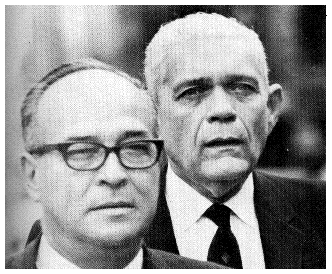Garrison's Case Finally Coming Togetherby Martin Shackelford
In 1969, government secrecy severly hampered the investigation by New Orleans District Attorney Jim Garrison into the assassination of President Kennedy. Today, with the documents released under the JFK Records Act, some of that secrecy has crumbled, and elements of Garrison's case look stronger today than in 1969. Perry Raymond Russo, the key witness who described conspiratorial conversations including the defendant Clay Shaw and the deceased David Ferrie, maintained the veracity of his testimony until his death in 1995. The case was sabotaged, however, by Garrison's inability to establish supporting claims that David Ferrie had long known Lee Harvey Oswald, and that Clay Shaw was connected to the CIA. There is no longer any doubt that both of these claims are true.
As late as 1993, with the publication of Gerald Posner's book Case Closed, Garrison's critics were denying that David Ferrie was in the Civil Air Patrol in New Orleans at the same time at Oswald (the mid-1950s), despite contrary witness testimony. Shortly after the publication of Posner's book, however, the PBS news program "Frontline" located two photographs showing Ferrie and Oswald together at a CAP barbecue; one, shown on the program "Who Was Lee Harvey Oswald?," has since been widely published. In addition, former Deputy Counsel Robert Tanenbaum of the House Select Committee on Assassinations has stated that his staff located a film showing Oswald and Ferrie at an anti-Castro training camp near New Orleans in the summer of 1963. Clay Shaw's connections to the Central Intelligence Agency are now thoroughly documented. Though he told reporters he was in the Medical Corps during World War Two, documents show that he worked for an Army Counterintelligence group called the Special Operations Section. His military record remains classified. In Europe, he became involved with a Rome-based CIA front organization, the Centro Mondiale Commerciale. Between 1948 and 1956, he filed reports with the CIA's Domestic Contact Division, and provided documents to the Foreign Documents Division. The CIA paid for one of Shaw's trips in 1955, and the following year he actively solicited information for them. Although a CIA internal report described him as a valuable informant, his formal connection with the Agency suddenly ended in 1956. His CIA activities, though, continued. The House Select Committee on Assassinations learned, but didn't report, that Shaw was heavily involved in anti-Castro activities; he allowed one group rent-free space in his International Trade Mart. He had a working relationship with former FBI agent Guy Banister, many of whose former employees now confirm that Banister employed Oswald in the summer of 1963. As late as 1967, Shaw had a "covert security" classification for a top secret program called QKENCHANT. The program remains so highly classified that we are still unable to learn anything about its nature, but Shaw's classification was approved by the CIA's then covert operations chief, Richard Helms, and we know that clearances were being granted in December 1962. Former CIA official Victor Marchetti said that QKENCHANT was most likely run out of the Domestic Operations Division of the Clandestine Services, run by Tracy Barnes. Support for this comes from recently-released documents identifying Barnes' then-deputy, E. Howard Hunt, as another individual involved with QKENCHANT. We also know that a pilot was considered for clearance for the program. One of the few others known to have been cleared for QKENCHANT was Monroe Sullivan, director of the San Francisco Trade Mart, and Shaw's alibi witness for November 22, 1963. At the time of the House Select Committee investigation in 1976, inquiries to the CIA about Clay Shaw were coordinated by J. Walton Moore, the former Dallas CIA contact for Oswald's friend George DeMohrenschildt. Another recently-released document connects Shaw to the top secret project ZRCLIFF, which was run out of William Harvey's super-secret Staff D along with the ZRRIFLE assassination program. In February 1967, New Orleans CIA office Chief Lloyd Ray wrote to the Director of the CIA's Domestic Contact Service:"We believe that there is some truth in the allegation of the Garrison investigation and the matter is under a discreet and sensitive investigation by the FBI." A September 1977 memo written by HSCA staff counsel Jonathan Blackmer concluded: "We have reason to believe Shaw was heavily involved in the anti-Castro efforts in New Orleans in the 1960s and possibly one of the high-level planners or 'cut out' to the planners of the assassination."
|

